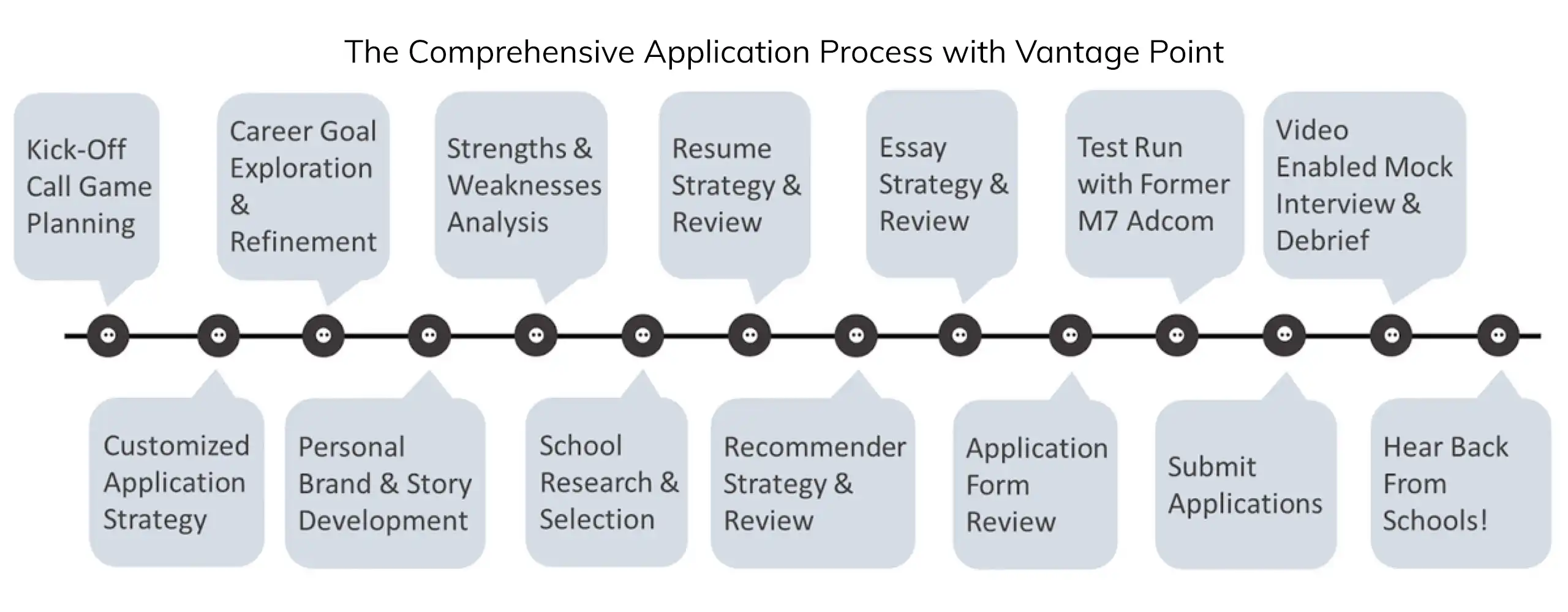Understanding the MBA Application Process: Five Things You Can Be Doing Right Now

Originally published on January 18, 2024. Updated on January 16, 2025.
Yes, it’s only January, and it may seem like you have plenty of time before the first round of MBA application deadlines. However, there are several crucial steps you can take right now to give yourself a head start (and reduce your stress in the fall).
We recommend laying out a month-by-month timeline for the year. Assume everything will take longer than you think—because it often does. Best case, things go faster, and you’re ahead of the game. Worst case, you’ll still be on track.
Not sure where to begin? Let us help you create a customized plan to tackle the MBA application process with clarity and confidence.
1) Schedule Spring Class Visit
Many applicants are surprised—often not in a good way—by how little time there is to visit schools in the fall before Round 1 application deadlines. Spring is the ideal time to plan your visits because you’ll want to go while classes are in session (and not during summer break).
If you’re planning to apply in Round 1, which is a smart move if you’re already thinking about the MBA application process, aim to schedule your visits this spring. Visiting in the spring not only ensures you have time to visit, but also allows you to interact with students when they’re less stressed by recruiting. You’ll be able to hear directly from both first- and second-year students, who can share their recent experiences and insights.
School visits are invaluable for assessing which programs are the best fit for you. They also provide specific details about clubs, classes, and culture that are hard to grasp from a website alone. In our experience, applicants who visit schools tend to write stronger essays than those who don’t.
2) Take the GMAT or GRE ASAP
Knowing your GMAT or GRE score early in the MBA application process is helpful for several reasons. While it’s not the only factor schools consider, your score should guide how you shape your list of target schools and begin researching them.
If your score isn’t what you hoped for, learning this early gives you time to take action. You might consider taking extra classes to strengthen your academic profile, retaking the exam, or even switching tests if the one you initially attempted isn’t working for you.
Finally, by getting the test out of the way, you’ll free up your time and energy to focus on the strategic parts of the application process—like defining your story and career goals.
3) Get Those Coffee Chats on the Calendar
An MBA is more than an academic degree. It’s a holistic experience with many aspects that are hard to understand without having been there yourself. Seek out people in your network who can talk to you about their MBA experiences.
Not only will having these conversations early help you collect information to accelerate your process, it could also lead to stronger advocacy for you by these individuals if they write your recommendations later on. Everyone likes to see someone being proactive!
For more advice on how to effectively network as part of the MBA application process, check out our article: Networking for Your MBA Applications.
4) Be Honest About Your Weaknesses
It’s easy to find information about what schools are looking for in candidates. Take some time to think critically about your areas of weakness and make a plan to address them over the coming months.
Typical areas of weakness include:
- A low undergraduate GPA
- A less-than-ideal GMAT or GRE score
- Limited extracurricular involvement
- Limited leadership experience
If GPA is one of your concerns, we created this guide with advice on practical steps you can take to strengthen your application.
5) Start Thinking About Your Goals Now
Being able to clearly articulate why an MBA is the right degree for you—and what you plan to do with it—is an essential part of the application process. MBA programs have limited seats, so they look for candidates who will leverage the degree to achieve meaningful goals and make an impact.
For 75% of the people we work with, defining their goals is one of the hardest parts of the process. It takes time, conversations, research, and often a bit of soul-searching.
We recommend starting by reviewing the job placement reports for your target schools and exploring LinkedIn profiles of professionals whose careers interest you—whether they’re co-workers, family friends, or alumni. This research will help you understand what’s possible and give you a clearer picture of opportunities that align with your ambitions. From there, you can refine your goals to align with your story and the strengths of the programs you’re targeting.
If you’d like expert guidance on defining your goals or creating a personalized plan for your MBA application process, reach out to request an initial consultation. Starting early can make all the difference.





Pingback: The Real Cost of an MBA from a Top Program The Real Cost of an MBA from a Top Program
April 3, 2025 3:10 pm